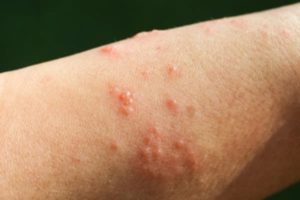Contact dermatitis is when something touches your skin and causes irritation or an allergic reaction that leads to an itchy, painful rash. With the proper prevention and skincare strategies, you can help heal your skin and stop another rash from occurring. Here’s how to avoid catching contact dermatitis this summer and beyond.
Like Finding a Needle in a Haystack
Each season brings a new list of things that can irritate our skin. Most individuals spend more time outside in the summer. As a result, it increases our opportunity to come in contact with irritating substances and external environmental elements that trigger unwanted skin rashes. This includes:
- Sun exposure
- Increased sweating from heat and humidity
- Plants and shrubbery like poison ivy, poison sumac, poison oak, and some flower varieties
- Chlorine from swimming pools
Identifying what’s causing your contact dermatitis is the most effective way to treat your skin. Yet, seasonal changes are only a drop in the bucket of allergens that can trigger a rash. With over 1500 types of allergens, it can be like searching for a needle in a haystack without a dermatologist. Using the location of the rash, the American Academy of Dermatology’s website shares some insight on what to look for.
Self-Care and How Texas Dermatology Can Help
Knowing what’s causing contact dermatitis to occur is a large part of preventing it. However, dry skin and other factors could trigger a reaction too. At the same time, you should also know how to care for your skin, so the following when it comes to managing contact dermatitis:
- Proactive Prevention:
- Apply a fragrance-free moisturizer or barrier repair cream after washing and throughout the day when your skin feels dry. This helps seal in moisture and protect your skin from drying out and potentially triggering another rash.
- Wear lightweight, protective clothing to create a barrier against plants and other external factors and wick away moisture, so your skin stays dry.
- Use a water-resistant, broad-spectrum sunscreen with an SPF of 30 or higher for extended outdoor activity. Reapply every two hours or after swimming or sweating.
- Wash any new clothes before you wear them to remove chemical residues and dyes that could cause a reaction.
- Self-Care:
- Stop scratching. The rash can be itchy, but scratching tends to worsen the rash. Scratching can also lead to an infection.
- Cool compresses, anti-itch medication, or oatmeal baths are effective in relieving the itch:
- Apply an anti-itch medication that contains 1% hydrocortisone to your rash
- Slather calamine lotion on your itchy skin
- Soak in a cool oatmeal bath.
- To make a cool compress, run cold water over a clean towel, then apply the cool, damp towel to the area for 10-15 minutes a few times daily
If the rash is persistent or you cannot manage it at home, it’s time to see the board-certified dermatologists here at Texas Dermatology. Dermatologists are experts in all aspects of our skin. They can perform tests that help identify the cause easier or whether it’s the effect from another skin issue or medical condition.
Call us at (210) 829-5180 or book an appointment through our online portal today!
Sources:
https://www.aad.org/contact-dermatitis-tips
https://www.aaaai.org/tools-for-the-public/conditions-library/allergies/summertime-skin-rashes










